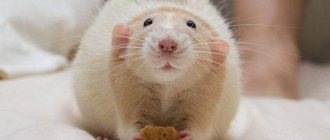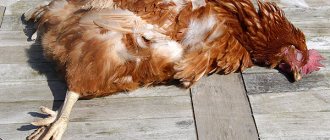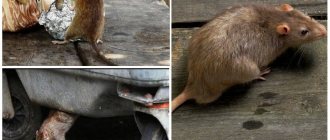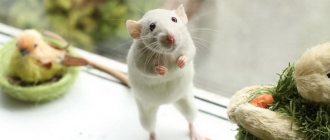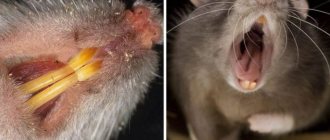Features of breeding decorative rats
When getting a female, you need to know that a decorative rat at home is ready to breed throughout the year. Therefore, it is important to know how to care for a pregnant rat, how to help during childbirth if difficulties arise, and what to do with the offspring.
If you decide to breed rats on a professional level, you need to select only healthy rats for a pair; before mating, you need to pay attention to the diet of the future parents.
By approaching this issue with all seriousness and responsibility, you will get healthy offspring.
Types of breeding
In order for the offspring to be born viable and beautiful, experienced breeders recommend breeding only one type of rat. This kind of breeding is called pure breeding; the advantages of this type are the preservation of the basic qualities of the species and their improvement. Pure breeding is divided into linear and family.
Linear type - for reproduction they take rodents that have common parents, the successor of the family is a male, the female is selected according to external characteristics.
Family species - both females and males from common parents, which are selected according to certain parameters, can be used for reproduction.
In order to breed a new species of decorative rat, not only linear individuals are crossed, but even from different species.
In addition to these species, inbreeding is distinguished - mating of closely related individuals other than mother and son. This method allows you to draw not only a clean line, but also to emphasize the best qualities of a certain type. But such offspring can have various mutations, viability decreases and such a genus simply degenerates.
According to the observations of experienced breeders, in order to get the best results when breeding decorative rats, you need to take two females and one male. To breed Dumbo rats, they take representatives of the same genus, at least 6 months old.
Factors affecting reproduction
The most basic factor that has a significant impact on reproduction is health. A genetic factor or an unfavorable environmental situation can provoke the development of various ailments in subsequent generations. The table contains a detailed list of possible unfavorable factors and the consequences they cause:
| Heredity | Ecology/Environment |
| Minor Recessions | Mutations |
| Sudden mutations | Severe diseases of various organs |
| Genetic incompatibility | Weak immunity |
Besides health, an important factor is the rat's temperament. Experienced breeders recommend paying attention to their character: rats that show aggression are not recommended as a breeding pair.
Estrus and heat
During estrus, the female is ready to mate, and this can be easily understood - you need to tickle her in the spine area, the rat should arch her back and shake her ears.
At the end of estrus, rats begin a period of sexual heat, this is easy to understand by watching the pet - the rat will stretch out its hind legs and spin around the male, they will show interest in each other - licking and sniffing the partner.
The rat is in heat
The main difference between female rats and other animals is the absence of vaginal bleeding, due to the fact that their red blood cells are not visible. But, like other animals, the rat is sensitive towards the male during estrus.
The duration of estrus is determined by several factors - the environment and the individuality of the rat's body. For example, light during the day and at night can affect the cycle and cause it to become unstable, or a new neighborhood, and as a result, stress can also play a role. When planning a pregnancy, this should be taken into account.
Regarding the frequency of estrus - in rats bleeding occurs every 5-6 days, lasting about 15 hours. To understand when a rat is in heat, it is worth observing its genitals. During estrus, her perineum is moist and open, and when she is not in estrus, the perineum is dry and tightly compressed.
Sexual heat in males
Males become fully sexually mature at the age of 5 months, from this period they will respond to the mating games of the female. It is quite simple to understand that a male is interested in a female who is in heat: he will sniff her, lick her and try to mount her.
Rats mating
It happens that a female during estrus shows aggression towards the male; she herself approaches him, sniffs his genitals, threatening him, and can drive him into the corner of the cage with her teeth; such moments are called mating games.
If the female has not given birth before and has not had a partner, she may exhibit increased excitability, and it will be difficult for the partner to cope with her, and at the moments when he succeeds, the rat will break free. Don’t worry, after a short period of time she will calm down and allow the male to approach.
In this regard, the reproduction of domestic rats is not much different from the reproduction of wild rats; in nature, the behavior of representatives of both sexes is the same.
How do rats mate?
The mating process depends on the female’s cycle, and can last from 2 to 24 hours, despite the fact that the sexual act itself is not long, it can be repeated several times.
8 hours after the start of estrus, female rats ovulate, but they can become pregnant within the next 24 hours after intercourse.
When do rats mate?
Rats in the wild breed in the spring and summer, while decorative rats are ready to mate all year round. But it is important to remember that the presence of stressful situations, insufficient or improper nutrition, as well as insufficient care can affect the fertility of the female.
Selecting a breeding pair
In order to obtain good results - healthy and beautiful offspring, you should approach the choice of a pair with special responsibility.
The best representatives who have characteristic breeding qualities are selected.
The choice of a female for future offspring is also important - she should be between 5 and 10 months old; if the female has not yet given birth, she should not be older than 8 months of age.
Breeding rats at home is different from breeding rats in the wild. In the animal world, individuals independently select a mate for themselves based on personal warnings - appearance, habits, position that the individual occupies in the pack, and having chosen the best candidate, continues the race.
At home, the owner decides for the rats, based on the purpose of having offspring. But in both cases, the goal is healthy offspring capable of survival.
When choosing a pair, you should consider:
- The prospective couple must be in a stable emotional background.
- The couple must be completely healthy.
- It is worth choosing young rats; old individuals may not produce viable offspring, and there is also a risk to the health of the rats.
- It is advisable to find out the pedigree - regarding the health and habits of the species.
These parameters have a great influence on subsequent offspring.
How to select and prepare rats for mating
The best representatives of a certain species are selected for mating; breeders recommend that future parents live separately and meet only for the mating period.
Moreover, after giving birth, the female begins to go into postpartum estrus, and if sexual intercourse occurs, the chances of becoming pregnant with an unrestored body are very high, which is extremely undesirable.
Rat behavior after birth
Domestic rats, most often, are good mothers; a caring attitude towards each newborn baby is inherent in nature itself, but some individuals sometimes lack maternal instinct. It happens that firstborns can ruin their first offspring, but at the next birth they become diligent mothers.
After a difficult birth, due to stress and a surge in hormones, the rat may lack milk, or the female may not want to feed her babies. In such cases, it is necessary to intensively feed the female mainly with protein foods with the addition of fruits and vegetables. Sometimes babies are supplemented with baby food with the addition of condensed milk, but this is very difficult to do, and a rat can eat baby rats with the smell of human hands.
It is advisable to create a comfortable, calm environment for the rat that gave birth; the rodent will calm down, recover after giving birth and can begin to care for the babies. If the pet continues to refuse to feed and care for newborns, it is advisable for them to find a foster mother, this could be a nursing female rat or domestic mouse.
Pregnancy and childbirth
It is quite simple to understand whether a rat has become pregnant: if pregnancy has occurred, then the next estrus simply will not occur. Also, in the absence of estrus, pregnancy is manifested in the behavior of the rat:
A pregnant female will try to take a leading position among other females, taking away food, limiting others, thus becoming the alpha female. Other rats, realizing that this female is pregnant, will give her the necessary food without any problems; in addition to food, they will give free space to the expectant mother if the pregnant rat needs it.
After a couple of weeks, a pregnant rat will notice a noticeable increase in weight, the belly will visually become rounded, but if the rat is large and the future litter is small, visual signs of pregnancy may be almost invisible.
Often, birth in rats occurs on the 21st day of pregnancy , mainly in the evening or at night, it happens that females continue nursing until the 23rd day, this is absolutely normal, you should be concerned if the rat does not give birth after this time, in this case it is better to seek advice from veterinarian
It is not recommended to pick up a pregnant female, or do it very carefully so as not to harm the babies or mother.
A week before the expected birth, experienced breeders recommend tracking the rat into a separate cage; such actions will make the rat feel completely relaxed in preparation for meeting the offspring. After giving birth, the rat stays in the same cage with its babies, so the new home should be spacious and comfortable.
Feeding a pregnant rat
A pregnant female will be nesting, so it is important to place food and water near the site so that the expectant mother does not have to constantly walk.
A pregnant female should eat well, her food should be rich in proteins, for this it is worth including in the diet:
- meat;
- fish;
- bread;
- milk, etc.
Food is given in the same quantity as before.
Childbirth in decorative rats
In a normal pregnancy, not burdened by any problems, birth occurs on the 21st, or maximum on the 23rd day of gestation. Childbirth is a natural process, so you should not interfere with it, but you need to be prepared in case of possible problems and know how to help a rat give birth.
Childbirth process
In the last week of pregnancy, the rat gains a lot of weight and it is during this period that it begins to “build” a nest. The main signs of impending labor:
- a rat licks its genitals;
- Drops of blood may appear on the litter.
During this period, it is better to leave the rat alone and not disturb it.
But you need to know the symptoms that should alert you and cause you to contact a veterinarian:
- The bleeding lasts more than a day.
- The rat became restless.
- The rat shows signs of apathy and frustration.
- Pallor is noticeable on the pet's skin.
- The pregnancy has come to an end and labor has not begun.
During the birth process, the female stops eating and tries to retire. The beginning of contractions can be indicated by the position of the rat's body - it lengthens and the sides of the abdomen retract. When the babies are ready to be born, the female sits down, helping herself to push out the fetus; she can help herself with her teeth and claws.
Each newborn rat appears in a pouch, the rat chews it, and licks the baby and gnaws the umbilical cord. Licking a baby is an important process - this action stimulates the lungs, and if the baby is born alive and healthy, it should squeak, this will be a sign that everything is going according to plan. If the baby is stillborn, most likely the rat will eat it.
Often, childbirth in a rat lasts about 2 hours; if the process lasts longer, this may indicate problems; it is worth intervening and trying to help your pet:
- The female is tired - to restore strength, you can give the rat half a teaspoon of honey and massage the abdomen, such actions should cause new contractions.
- The fetus moves feet first - the baby's tail or paw may stick out from the perineum, in this case you need to take a dry, warm towel or napkin, wrap the baby and gently pull.
If this does not help, the rat may need surgery, in which case the best solution would be to contact a veterinarian.
Caring for a rat after birth
After giving birth, the rat will take care of the babies - clean them of mucus, gnaw the umbilical cord and allow them to the nipples. The new mother needs to put weak tea in the cage, to which you can add milk or cream, this will help restore the strength spent on the birth process. After which the rat should be left alone and allowed to rest.
Learn more about caring for your rat after birth
What to feed a newborn rat
The diet of a female who has given birth should be nutritious with a high protein content; to exclude osteoporosis, you can give the animal calcium gluconate in tablets. In the absence of proper feeding, a rat can eat newborns. To restore strength after childbirth and stimulate milk production, it is recommended to feed the rodent the following foods:
- concentrated soy milk;
- quality cat food;
- kefir, yogurt and cottage cheese without dyes and preservatives;
- milk porridges and dry cereals;
- boiled chicken wings and necks;
- vegetables and fruits;
- children's fruit, vegetable and meat purees from jars.
Protect your pet from the close attention of curious household members and create comfortable conditions for her, soon the babies and the rat will get stronger, and you will be able to enjoy communication with the touching little rats.
Birth of the brood
After giving birth, the rat can eat the entire litter, experiencing stress! To prevent this from happening, you should:
- do not touch or look at babies;
- do not touch the female;
- remove play accessories from the cage;
- put paper napkins in the cage;
- There is no need to clean the home, you can only pick up heavily soiled pieces of napkins so as not to accidentally destroy the nest;
- Monitor the availability of food and water.
The number of offspring may depend on the species to which the female belongs; for convenience, consider the table:
| View | Duration of pregnancy | Duration of the lactation period | Number of litters | Number of cubs |
| White rat | 20-25 | 21-23 | 5 | up to 20 |
| Gray rat | 20-25 | 22-23 | 5 | up to 20 |
| Black rat | 20-25 | 22-24 | 5 | up to 7 |
Caring for newborn rat pups
It happens that the female does not care for newborn rats, there are several reasons for this: the litter is too large, or if the cub cannot get to the milk, as well as other reasons. In this case, caring for the little rats falls on the owner.
During the first days there is no need to touch the mother and babies, but after a while you can start getting to know the offspring. According to the advice of experienced rat breeders, if the newborns are introduced to each other before they open their eyes, then the rats grow up to be very outgoing and sociable.
For the first couple of weeks, newborn rat pups eat only their mother's milk. Rats older than this age begin to show interest in solid foods and begin to understand tastes.
What to feed baby rats
Let's look at the feeding table for newborns by week:
| 1st week | 2nd week | 3rd week | 4th week |
| mother's milk or formula every 2-3 hours | mixture with grain feed, every 4 hours and once at night | the mixture with grain feed is poured into a bowl, night feeding is canceled | switching to dry food |
Also, up to 6 weeks of age, drinking cow's or goat's milk using a pipette is allowed. If the female feeds the babies with breast milk, then from the age of one month they, together with their mother, switch to regular food; the following can be added to the diet of newborns:
- dairy products;
- fruits;
- candied fruits, etc.
Artificial feeding of rat pups
If it happens that a rat refuses to feed newborns, you need to be prepared for the fact that feeding is a rather complicated process. It is best to use another lactating rat for this; if this is not possible, then the babies are fed with baby formula or a milk replacer. For convenience, use a pipette or insulin syringe. After each feeding, all items must be sterilized.
Artificial feeding
In some cases, when the female dies after giving birth or refuses to breastfeed, you can try to feed the cubs to the child's family. Insulin syringes are used for this. Infant formula is taken in the proportion of 1 part to 50 ml of condensed milk with a high fat content of up to 12%, including half a tablet of calcium gluconate. It is acceptable to use milk replacers for cats or dogs.
Feeding should be done frequently with gradually increasing portions. It is preferable to give such cubs to another lactating female if she accepts them.
In conclusion, it should be said that breeding rats is quite a fascinating process, but do not forget that by crossing different species you can create something completely unusual.
Did you like the article? Share with friends: [supsystic-social-sharing id=”1"]
- Related Posts
- How to Choose the Ideal Rat Cage
- How long do pet rats live?
- The rat itches until it bleeds, why?
« Previous entry

